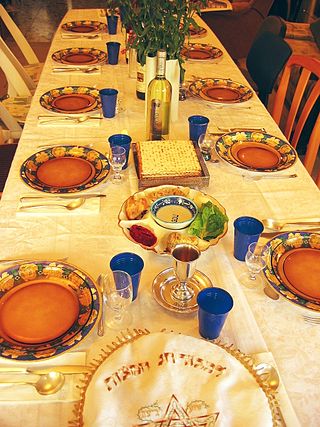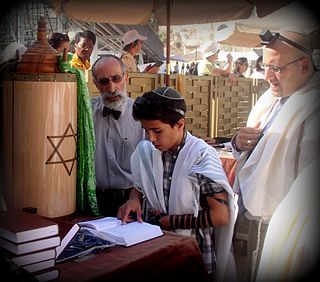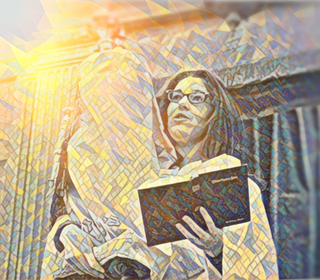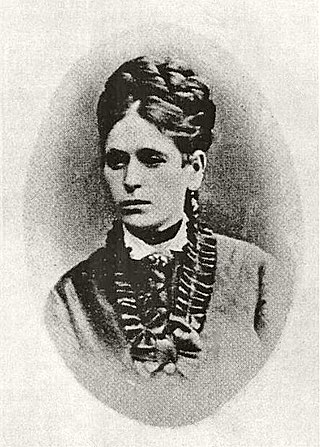Related Research Articles

Mordecai Menahem Kaplan was a Lithuanian-born American rabbi, writer, Jewish educator, professor, theologian, philosopher, activist, and religious leader who founded the Reconstructionist branch of Judaism along with his son-in-law Ira Eisenstein. He has been described as a "towering figure" in the recent history of Judaism for his influential work in adapting it to modern society, contending that Judaism should be a unifying and creative force by stressing the cultural and historical character of the religion as well as theological doctrine.

The Passover Seder is a ritual feast at the beginning of the Jewish holiday of Passover. It is conducted throughout the world on the eve of the 15th day of Nisan in the Hebrew calendar. The day falls in late March or in April of the Gregorian calendar. Passover lasts for seven days in Israel and, among most customs, eight days in the Jewish diaspora. Where seven days of Passover are observed, a seder is held on the first night; where eight days are observed, seders are often held on the first two nights, the 15th and 16th of Nisan. The Seder is a ritual involving a retelling of the story of the liberation of the Israelites from slavery in ancient Egypt, taken from the Book of Exodus in the Torah. The Seder itself is based on the Biblical verse commanding Jews to retell the story of the Exodus from Egypt: "You shall tell your child on that day, saying, 'It is because of what the LORD did for me when I came out of Egypt.'" At the seder, Jews read the text of the Haggadah, an ancient Tannaitic work. The Haggadah contains the narrative of the Israelite exodus from Egypt, special blessings and rituals, Talmudic commentaries, and Passover songs.

A bar mitzvah (masc.), bat mitzvah (fem.), or b mitzvah, is a coming-of-age ritual in Judaism. According to Jewish law, before children reach a certain age, the parents are responsible for their child's actions. Once Jewish children reach that age, they are said to "become" b'nai mitzvah, at which point they begin to be held accountable for their own actions. Traditionally, the father of a bar or bat mitzvah offers thanks to God that he is no longer punished for his child's sins.
The Union for Reform Judaism (URJ), formerly known as the Union of American Hebrew Congregations (UAHC) until 2003, founded in 1873 by Rabbi Isaac Mayer Wise, is the congregational arm of Reform Judaism in North America. The other two arms established by Rabbi Wise are the Hebrew Union College-Jewish Institute of Religion and the Central Conference of American Rabbis. The current president of the URJ is Rabbi Rick Jacobs.

The Hebrew Union College – Jewish Institute of Religion is a Jewish seminary with three locations in the United States and one location in Jerusalem. It is the oldest extant Jewish seminary in the Americas and the main seminary for training rabbis, cantors, educators and communal workers in Reform Judaism. HUC-JIR has campuses in Cincinnati, Ohio, New York City, Los Angeles, and Jerusalem. The Jerusalem campus is the only seminary in Israel for training Reform Jewish clergy.

Sally Jane Priesand is America's first female rabbi ordained by a rabbinical seminary, and the second formally ordained female rabbi in Jewish history, after Regina Jonas. Priesand was ordained by the Hebrew Union College-Jewish Institute of Religion on June 3, 1972, at the Plum Street Temple in Cincinnati. After her ordination she served first as assistant and then as associate rabbi at Stephen Wise Free Synagogue in New York City, and later led Monmouth Reform Temple in Tinton Falls, New Jersey from 1981 until her retirement in 2006. She is featured in numerous books including Rabbis: The Many Faces of Judaism and Fifty Jewish Women who Changed the World.

Judah Leib Gordon, also known as Leon Gordon, was among the most important Hebrew poets of the Haskalah.

The Passover Seder plate is a special plate containing symbolic foods eaten or displayed at the Passover Seder. It is used to show all the symbolic foods that are used for the Passover Seder.
Hebrew school is Jewish education focusing on topics of Jewish history, learning the Hebrew language, and finally learning their Torah Portion, in preparation for the ceremony in Judaism of entering adulthood, known as a Bar or Bat Mitzvah. Hebrew school is usually taught in dedicated classrooms at a synagogue, under the instruction of a Hebrew teacher, and often receives support from the cantor for learning the ancient chanting of their Torah portion, and from the rabbi during their ceremony since they must read from a Torah scroll, which has no Hebrew vowels, and very close together text and minimal line spacing; making it very challenging for almost anyone to read from.
Jewish feminism is a movement that seeks to make the religious, legal, and social status of Jewish women equal to that of Jewish men in Judaism. Feminist movements, with varying approaches and successes, have opened up within all major branches of the Jewish religion.

The Liberal Jewish Synagogue, abbreviated as LJS, is a Liberal Jewish congregation and synagogue, located in St John's Wood, in the City of Westminster, London, England, in the United Kingdom.

Miriam Markel-Mosessohn was a Russian author and translator who wrote in Hebrew.
Women's Rabbinic Network is, according to itself, “the organization of Reform female, nonbinary, genderfluid rabbis, supporting and advocating for our members and the values we uphold to positively impact women in the Jewish community.”

Moving Traditions is a Jewish non-profit organization that runs educational programs for teenagers. The organization was founded in 2005 and is based in Elkins Park, Pennsylvania.
An adult bar/bat mitzvah is a bar or bat mitzvah of a person older than the customary age. Traditionally, a bar or bat mitzvah occurs at age 13 for boys and 12 for girls. Many adult Jews who have never had a bar or bat mitzvah, however, may choose to have one later in life, and many who have had one at the traditional age choose to have a second. An adult bar or bat mitzvah can be held at any age after adulthood is reached and can be performed in a variety of ways.

The Maxwell House Haggadah is an English-Hebrew Passover Haggadah introduced by the Maxwell House company as a marketing promotion in 1932 and printed continuously since that time. With over 50 million copies in print, it is the best known and most popular Haggadah among American Jews, and is considered a cultural icon. It is used at Passover Seders in homes, schools, senior centers, prisons, and the United States Army, and was the edition used by President Obama and his guests at the White House Passover Seder conducted yearly from 2009 to 2016. In 2011 a new English translation replaced archaic phrases in the original and also incorporated gender-neutral language.

Judith Eisenstein was an author, musicologist, composer, theologian and the first person to celebrate a bat mitzvah publicly in America.

The Birds' Head Haggadah is the oldest surviving illuminated Ashkenazi Passover Haggadah. The manuscript, produced in the Upper Rhine region of Southern Germany in the early 14th century, contains the full Hebrew text of the Haggadah, a ritual text recounting the story of Passover – the liberation of the Israelites from slavery in ancient Egypt – which is recited by participants at a Passover Seder. The text is executed in block calligraphy and accompanied by colorful illustrations of Jews performing the Seder practices and reenacting Jewish historical events. The Birds' Head Haggadah is so called because all Jewish men, women, and children depicted in the manuscript have human bodies with the faces and beaks of birds. Non-Jewish and non-human faces are blank or blurred. Numerous theories have been advanced to explain the unusual iconography, usually tied to Jewish aniconism. The Haggadah is in the possession of the Israel Museum in Jerusalem, where it is on permanent exhibition.

Chava Shapiro, known also by the pen name Em Kol Chai, was a Russian Jewish writer, critic, and journalist. A pioneer of Hebrew women's literature and feminist literary criticism, Shapiro was among the most prolific of the diasporic women writers of Hebrew in the early twentieth century.

A Mi Shebeirach is a Jewish prayer used to request a blessing from God. Dating to the 10th or 11th century CE, Mi Shebeirach prayers are used for a wide variety of purposes. Originally in Hebrew but sometimes recited in the vernacular, different versions at different times have been among the prayers most popular with congregants. In contemporary Judaism, a Mi Shebeirach serves as the main prayer of healing, particularly among liberal Jews, to whose rituals it has become central.
References
- 1 2 "August Wedding for Carole Balin". The New York Times . 17 January 1988. Retrieved 24 April 2016.
- ↑ "Rabbi Carole B. Balin, PhD". The Huffington Post . 2016. Retrieved 25 April 2016.
- 1 2 3 4 5 6 "Carole B. Balin (curriculum vitae)" (PDF). Hebrew Union College-Jewish Institute of Religion. 14 June 2013. Archived from the original (PDF) on 20 December 2016. Retrieved 25 April 2016.
- ↑ Wertheimer, Jack (2007). Imagining the American Jewish Community. UPNE. p. 207. ISBN 978-1584656708. (footnote 12)
- ↑ Shrayer, Maxim D. (January 2002). "To Reveal Our Hearts: Jewish Women Writers in Tsarist Russia by Carole B. Balin". The Modern Language Review. 97 (1): 243–245. doi:10.2307/3735695. JSTOR 3735695.
- 1 2 Safran, Hannah (October 2003). "Book Review". Jewish History. 17 (3): 349–351. doi:10.1023/A:1024440320951. S2CID 160488465.
- ↑ "Carole B. Balin". Jewish Women's Archive. 2016. Retrieved 25 April 2016.
- ↑ Schorr and, Rebecca Einstein; Graf, eds. (2016). The Sacred Calling: Four Decades of Women in the Rabbinate. ISBN 978-0-88123-217-2.
- ↑ Tuohey, Patrick (6 February 1991). "Saint David, Star of David". The Record . Archived from the original on 11 September 2016. Retrieved 25 April 2016– via HighBeam.
- ↑ "The Jewish people [videorecording] : a story of survival / directed by Andrew Goldberg". National Library of Australia. 2008. Retrieved 25 April 2016.
- ↑ "Home". Bat Mitzvah Comes of Age. Archived from the original on 3 April 2016. Retrieved 25 April 2016.
- ↑ Balin, Carole B. (12 March 2012). "Bat Mitzvah Comes of Age: 90 Years of Transforming Jewish Girls to Women". The Huffington Post. Retrieved 25 April 2016.
- 1 2 "Bat Mitzvah Comes of Age". Moving Traditions. 2015. Retrieved 25 April 2016.
- ↑ "Museum Collaborates on Bat Mitzvah Exhibition with Moving Traditions" (PDF). Only in America: 1–2. Spring 2012. Retrieved 25 April 2016.
- 1 2 "Michael E. Gertzman, Partner". Paul, Weiss, Rifkind, Wharton & Garrison LLP. 2016. Retrieved 24 April 2016.